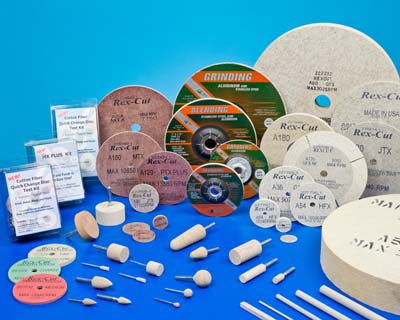
A full line of cotton fiber abrasive products for grinding, deburring, polishing, and finishing stainless steel, aluminum, and exotics is available from Rex Cut Products Inc.
Rex-Cut Cotton Fiber Abrasive Products feature multiple layers of non-woven cotton fabric impregnated with aluminum oxide or silicon carbide abrasives which are compressed with varying bond hardness for use on stainless steel, aluminum, and exotics. Continually exposing fresh abrasives while working, they run cool, provide smooth, chatter-free performance, and are capable of grinding, deburring, and finishing in one operation.
Unlike most bonded or coated abrasives, Rex-Cut Cotton Fiber Abrasive Products do not load up when working on softer metals or alloys and do not back transfer or smear on harder alloys. They include Type 1 straight-sided abrasive wheels, Type 27 depressed center wheels, Cut-N-Finish flexible discs, mounted wheels and points, quick change discs and sticks.
Contact Details
Related Glossary Terms
- abrasive
abrasive
Substance used for grinding, honing, lapping, superfinishing and polishing. Examples include garnet, emery, corundum, silicon carbide, cubic boron nitride and diamond in various grit sizes.
- alloys
alloys
Substances having metallic properties and being composed of two or more chemical elements of which at least one is a metal.
- aluminum oxide
aluminum oxide
Aluminum oxide, also known as corundum, is used in grinding wheels. The chemical formula is Al2O3. Aluminum oxide is the base for ceramics, which are used in cutting tools for high-speed machining with light chip removal. Aluminum oxide is widely used as coating material applied to carbide substrates by chemical vapor deposition. Coated carbide inserts with Al2O3 layers withstand high cutting speeds, as well as abrasive and crater wear.
- grinding
grinding
Machining operation in which material is removed from the workpiece by a powered abrasive wheel, stone, belt, paste, sheet, compound, slurry, etc. Takes various forms: surface grinding (creates flat and/or squared surfaces); cylindrical grinding (for external cylindrical and tapered shapes, fillets, undercuts, etc.); centerless grinding; chamfering; thread and form grinding; tool and cutter grinding; offhand grinding; lapping and polishing (grinding with extremely fine grits to create ultrasmooth surfaces); honing; and disc grinding.
- hardness
hardness
Hardness is a measure of the resistance of a material to surface indentation or abrasion. There is no absolute scale for hardness. In order to express hardness quantitatively, each type of test has its own scale, which defines hardness. Indentation hardness obtained through static methods is measured by Brinell, Rockwell, Vickers and Knoop tests. Hardness without indentation is measured by a dynamic method, known as the Scleroscope test.
- polishing
polishing
Abrasive process that improves surface finish and blends contours. Abrasive particles attached to a flexible backing abrade the workpiece.







